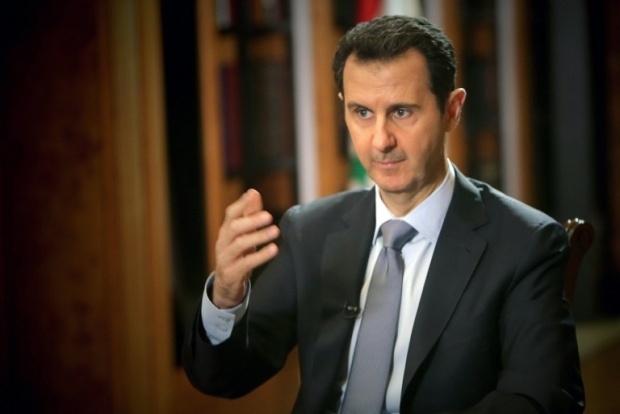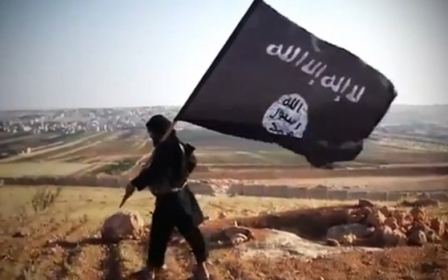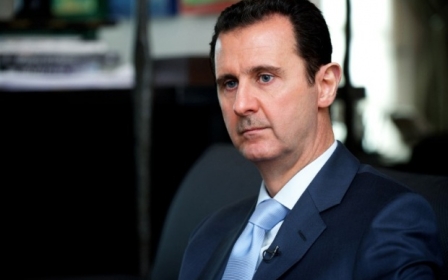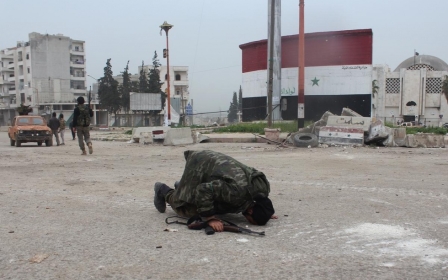Syria: Why is Assad still in power?

The Syrian conflict has entered its fifth year, and Bashar al-Assad is still in power defiant as ever. In fact, he appears to be increasingly confident after weathering the worst of the storm. The prospects for his removal or his regime’s collapse now appear increasingly remote after the US switched priority to defeating the Islamic State, relegating regime-change in Syria to the back burner indefinitely.
So why has he survived for so long in the face of such seemingly overwhelming odds? Why has he been able to withstand the major global powers, hostile neighbours on every border and tens of thousands of well-armed rebel fighters against him? The rise ISIS and its terror networks certainly played a large role by shifting the global focus away from his regime and onto how to counter the serious threats to global security posed by the group.
Russia, Iran and Hezbollah
The unwavering political, financial and military support of Assad’s ardent allies Russia, Iran and Hezbollah were also a significant factor in stabilising his regime’s control over territory. In fact, Hezbollah’s direct “boots on the ground” were instrumental in the conflict in rolling back rebel gains in several strategic fronts as well as securing the major urban population centres which are all still fully or partially under regime control. This with the exception of Raqqa that fell to ISIS after it was taken by rebels in 2013.
Aside from those two important factors, there is a third very crucial one which is mostly overlooked or under reported, as it does not fit neatly with the established rhetoric and narrative. This is especially so among the nations hostile to the Syrian regime or big global media organisations. The key to understanding the secret of the regime’s longevity is the continued support it enjoys amongst vast swathes of the Syrian population, albeit many Syrians do so out of fear of the alternatives.
Assad's popularity
What is not widely known is that before the uprising of 2011, Assad was a genuinely popular president who enjoyed broad support among most sections of Syrian society. He was even able to drive his own car and walk about in markets with a minimum visible security detail, often drawing large adoring crowds. There really was no need to manufacture this sort of propaganda in Syria, as is the case in most other dictatorships.
But the popular mood firmly flipped against him and his regime when the first Arab Spring inspired protests began to spread across Syria and were violently repressed with people being shot and killed on the streets. That was the lowest point of regime support, with only hardcore loyalists still championing its apparently losing cause. Many officials and army officers abandoned ship in anticipation of its imminent sinking. Contrary to what was being trumpeted at the time by various capitals around the world and an endless torrent of media and “expert” speculation on whether it would be this month or the next - the ship never sank.
In hindsight, this was just another method by which Syrians and global public opinion were tricked and misled, and the conflict got further entrenched and “hijacked” from a mass protest movement into a chaotic and destructive civil war. There was no conceivable way at all that protests alone, no matter how large, would ever remove such a powerful, pervasive and brutally shrewd regime without external military intervention. Any Middle East analyst worth his salt could have told you that.
Peaceful uprising crushed
Indeed, the mass protests were successfully crushed by the summer of 2011, and the Syrian army entered and restored government authority to all the restive towns and cities by force; the largely peaceful Syrian uprising was now effectively over.
Of course, the nations that were heavily invested in the regime’s removal thought otherwise, and the next phase began; an armed insurgency financed and supported by them. Meanwhile, the prevalent official and media narratives never changed as the violence in Syria escalated and a civil conflict - largely fuelled and sustained externally - engulfed the country. However, it was becoming increasingly clear that extremism, sectarianism and jihadist groups were on the rise and gaining dominance in the insurgency.
This was again whitewashed in favour of “the regime vs its own people” scenario, even though many of those people were now turning to the regime in droves because they were alienated by the war’s violence, destruction, fanaticism and warlordism of the many rebel groups.
This reversal of popular support back towards the government was the inevitable outcome of a failed and stalemated insurgency that had by now spawned ultra-extremist groups like ISIS and other affiliates of al-Qaeda. This is not to say of course that the Syrian regime does not pull out all the stops to ensure its survival, and in fighting urban warfare with limited manpower uses massive force and indiscriminate violence resulting in large loss of civilian life.
These war crimes are well documented. But there is an important distinction to be made here; the Syrian regime targets geographic areas under rebel control, not specific groups of people. This point is Illustrated when residents of those areas flee the fighting to the safer regime held areas, with very little incident of reprisals.
A prime example of support reversal is the minority Ismaili community, largely concentrated in the town of Salamieh in Hama. Salamieh was a hotbed of peaceful civil protest at the outbreak of the uprising but this is no longer the case. In fact, Salamieh is now a major regime bastion that protects its supply lines to the north and has been under frequent and heavy rebel attack, including the type which alienates the most, the random shelling of civilian areas.
This transformation in sentiment among the Ismaili community from passionate opponents of the Syrian regime to steadfast supporters, mirrors similar trends among Syria's religious minorities and a good chunk of its Sunni majority who are fearful of losing their conservative but moderate way of life to radicalisation.
Conversely, it means the opposite is true for the insurgency and opposition who nonetheless still retain sizable but incongruous support mainly concentrated in the areas where their fighters are drawn from. In the case of jihadi groups like ISIS and al-Nusra - which have a large contingent of non-Syrian fighters and an ultra-extremist ideology - popular support is gained through prowess on the battlefield and the ability to provide basic services, aid and a minimum level of law and order.
These are all feats that the mainstream West-backed Syrian opposition and its loosely affiliated but fractious "moderate" rebel groups have consistently failed to achieve, further eroding their support in favour of the more competent extremists.
Assad's support in Aleppo and Damascus
A regime that has no support among its own population cannot survive years of civil war, no matter how powerful it is or how much support it gets from abroad, it just goes against all logic. A large part of the Syrian population still inside the country still supports the regime. Many are from Syria’s numerous and diverse religious minorities, but a sizable number are also from the Sunni populations in the large and cosmopolitan cities of Damascus and Aleppo.
This is a startling statistic after three years of civil war, and not one you are likely to read about in the news anytime soon. Worse still, if you’re in the Middle East, the Syrian conflict is framed by the dominant Gulf-owned pan-Arabian news networks that strongly back the insurgency as a fully sectarian Shia vs Sunni issue. This helps galvanise support - and initially even recruits - to the anti-regime cause and keeps Arab public opinion - mostly Sunni Muslim - on side.
The Sunni split
The truth, however, is far more nuanced, though there is definitely a sectarian dimension to the Syrian conflict and significant internal polarisation along those lines. The Syrian army is largely made up of Sunni conscripts, while many willing Sunni volunteers in the paramilitary groups that support regular government forces fight alongside foreign Shia militias, like Hezbollah, against a plethora of rebel groups that are all exclusively Sunni Muslim of varying extremes - both local and foreign. It is this Sunni split in Syria that is perhaps the most significant but overlooked factor in shaping the conflict.
A protracted civil war also favours the most powerful player on the ground and the one that can provide stability, or at least the prospect of it, no matter how dim. In Syria's case this happens to be the central state, which for all intents and purposes is the ruling regime. They are inexorably and organically linked together, hence getting rid of the regime would also destroy central government. Absent any credible viable alternatives, this would cement the failed state status of a Syria embroiled in constant internal conflict for decades to come.
The dangers of collapse
This sort of central collapse would also almost certainly see jihadist groups fill the void, creating even more powerful extremist mini-statelets, the ideal breeding ground and export hub for terrorist fanatics. As you can imagine, this is not a prospect welcomed by most Syrians, nor indeed one of the most powerful backers of the opposition and insurgency, the United States. It is, on the contrary, an acceptable outcome for others like Israel, Turkey, Saudi and Qatar, who are obsessed with regime change at any cost despite the catastrophic consequences a disorderly collapse would have on the nation, and the profound wider-reaching repercussions.
This scenario plays well with their strategic regional interests of countering Iranian influence and hegemony in the Middle East, which in the case of the Gulf States and Israel is viewed as an imminent existential threat. A fractured Syria would deny Iran an important ally, and enable them to retain permanent spheres of influence in the north and south of Syria through their proxy rebel militias. They can then accommodate or deal with the extremist groups in the long term, at least that’s their flawed reasoning. This intransigent self-interest is one of the major obstacles to reaching a lasting political settlement to the conflict.
Stability, services and incomes
Amid all this fear and uncertainty we cannot underestimate the psychological and pragmatic attachment of many Syrians to a central government that continues to provide at least the bare minimum of public services, civil bureaucracy and state institutions including policing, free healthcare, education, as well as salaries and pensions to hundreds of thousands of civil servants and government employees. This is the case even for those living in opposition or ISIS territory. For many families, this is their only source of income.
Syria is a nation split along geographic and demographic lines and those divides grow ever deeper the more intractable the fighting gets. There is no realistic prospect of a military victory for any side anytime soon. In the meantime, the plight of ordinary Syrians continues to get ever more desperate as extremist groups take advantage of the chaos to sow terror at an industrial scale.
The only solution to this conflict - as has been repeated time and again - is a negotiated political settlement. The only way to achieve that is to sit down and talk with the ruling regime no matter how unpalatable or controversial that may seem. For all of its reprehensible acts, the ruling regime represents the central state, the Syrian army and a sizable chunk of Syrians and their interests.
It would be folly to ignore all that and keep pushing the same shortsighted narratives that have lead us nowhere except to more violence. At the end of the day, it is the enemy you negotiate with to end war, not your friends.
- Edward Dark is MEE's Aleppo-based columnist and writes under a pseudonym.
The views expressed in this article belong to the author and do not necessarily reflect the editorial policy of Middle East Eye.
Photo: Bashar al-Assad on 28 April 2014, Damascus, Syria (AFP)
Middle East Eye propose une couverture et une analyse indépendantes et incomparables du Moyen-Orient, de l’Afrique du Nord et d’autres régions du monde. Pour en savoir plus sur la reprise de ce contenu et les frais qui s’appliquent, veuillez remplir ce formulaire [en anglais]. Pour en savoir plus sur MEE, cliquez ici [en anglais].





